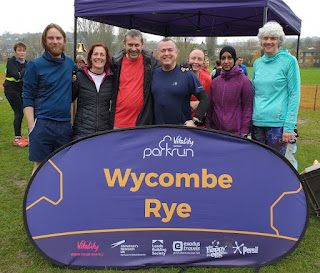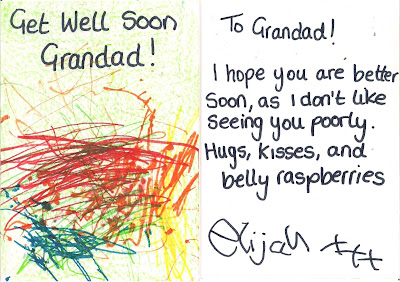Heart Attack to 10K (part 4.17) - Get that crazy rhythm (the low down on AFib)
Part 4.17 - Get that crazy rhythm (the low down on AFib)
(Phase VI - sustaining a healthy life-style)
My biggest concern of late has without doubt been Atrial Fibrillation (also known as AFib or AF) and its quite noticeable from my conversations that many 'non-hearties' have no idea what this actually is, despite it being a fairly common heart condition which could hit almost any adult, regardless if you have a pre-existing heart condition or not.
Atrial fibrillation is the most common erratic heart rhythm disturbance, affecting around 1.5 million people in the UK alone, however it is estimated that a further 500,000 remain undiagnosed due to a lack of awareness. It can affect any adult of any age, but it's more common in older people with more men than women suffering with this condition. Did you know that someone with AF is five times more likely to have a stroke than someone without AF, with a further risk of heart failure both are serious and potentially fatal conditions if left untreated - so it is certainly worth being aware.
Much of which follows (down to the hearts break line below) is copied from the highly informative Dr AFib website, a fantastic resource on this subject:
Understanding AFib Progression
Atrial fibrillation (AFib) is an erratic heart rhythm that happens because of an interruption in the heart’s regular electrical conduction pattern. The altered electrical signals cause the two upper sections of the heart, known as the atria, to lose their proper connection with the two lower chambers, called the ventricles.
AFib affects millions of people and often causes symptoms such as shortness of breath, fatigue, dizziness, chest discomfort, and weakness. If you have AFib, chances are you have experienced some or all these symptoms.
For some individuals, AFib will resolve by itself, but for others, it can grow into a long term if not a permanent problem. AFib is often a progressive condition for many people, meaning that the symptoms will increase in frequency and tend to last longer.
Unfortunately, restoring the heart’s natural rhythm, called a normal sinus rhythm, is difficult when AFib is present over a long period. As AFib worsens, managing it becomes challenging for both the individual suffering from it and their healthcare team.
Types of AFib
There are four different types of atrial fibrillation:- Paroxysmal AFib occurs without warning, lasts less than a week, and can resolve without any medical treatment.
- Persistent AFib lasts longer than a week, can return to a normal rhythm on its own, or sometimes requires medication or intervention to correct.
- Long-standing persistent AFib means that your condition lasts for at least a year and doesn’t stop without treatment.
- Permanent or chronic AFib is not correctable with medication or a procedure such as electrical cardioversion or ablation. This type often requires that you take medication long-term to help control your heart rhythm and rate and reduce your chances of having a stroke.
How Does AFib Progress?
AFib often causes AFib, which means that when an episode occurs, it increases the chances that a recurrence will happen.
Over time, episodes can become longer and occur more often. This increased frequency is due to changes in the heart’s structure and electrical activity that AFib creates.
When AFib progresses, it usually changes from a type that can end on its own to a variety that is constant. As far as the impact on your health, the speed at which this transformation happens, which your physician refers to as the progression rate, is sometimes more important than the length of the incident.
In some cases, AFib moves from paroxysmal to a persistent variety. For people with a new onset of paroxysmal AFib, 10 to 20 percent will experience a progression to persistent AFib after one year.
 |
| One of my own Kardia Mobile AFib traces |
Other diseases that contribute to AFib progression include coronary artery disease, high blood pressure, heart failure, sleep apnea, obesity, diabetes, and hyperthyroidism. Men also have a higher risk of AFib progression than women.
The rate of AFib progression also depends on how well you follow your prescribed treatment plan.
Slowing the Progression of AFib
If you have AFib, there are some initial self-care steps you can take to reduce the risk of AFib progression. Most of these changes are ones you can make that will improve your overall health such as:
- Starting and maintaining a regular exercise program.
- Following a heart-healthy diet that includes lots of fresh or frozen fruits and vegetables and keeping your intake of canned, processed, and packaged foods to a small amount.
- Reaching and maintaining a healthy weight.
- Avoiding monosodium glutamate, which will trigger AFib episodes.
- Stopping your use of any tobacco products.
- Limiting or abstaining from consumption of alcoholic and caffeinated beverages.
- Checking with your physician before taking any over-the-counter cold medications or herbal supplements.
If AFib is persistent, medication therapy can help control your rhythm and rate to reduce the strain on the heart muscle. Standard categories of medications used for treating persistent AFib may include:
- Antiarrhythmics such as flecainide and sotalol.
- Rate control agents like atenolol and metoprolol.
- Anticoagulants like warfarin, which help prevent stroke.
- Antiplatelet medication such as aspirin and Plavix.
Synchronised cardioversion, which uses electricity to shock the heart back into a normal rhythm, is often used as a short-term solution.
According to a research study the June 2015 issue of the Journal of American College of Cardiology, catheter ablation is a practical choice for reducing the progression of the persistent forms of AFib.
For people with other heart-related issues who are candidates for open-heart surgery, a maze procedure is also an option. The technique is like catheter ablation and uses radio waves or intense cold to create a system of scar tissue that stops the transmission of irregular electrical signals.
The progression of AFib depends on many factors, such as your age when the first event occurred, your complete health history, lifestyle habits, and the type of AFib you have. These factors will dictate the treatment plan that your healthcare team designs for you.
Regardless of how little or how much your AFib progresses, it is important to consistently follow your treatment plan to ensure that you have the best possible outcome.
- Dr Afib is a really useful resource for information on AFib where I have learnt much about the condition .... link
- NHS - Overview, Atrial fibrillation .... link
- BHF - Atrial fibrillation (AF): causes, symptoms and treatments .... link
- Health Unlocked - Living with atrial fibrillation, BHF learning program ..... link
💗💗💗💗💗💗💗💗💗💗💗💗💗💗💗💗
 |
| Parkrun turbo booster |
- Diet
- Alcohol
- Caffeine
- Sleep deprivation
- Fatigue
- Illness
- Testosterone
- Emotions
- Exercise
- Medication
- Dehydration
- Stress
So far since I started keeping records in May 2020 (18 months) when I invested in a KardiaMobile ECG reader, I have recorded 16 episodes each lasting between 4 hours to 96 hours with an average duration of 35.25 hours.
I only have the single lead Kardia but at around £100.00 it has been one of my best buys over the last few years. This device sits in your pocket and links to your smart phone so you can carry out an instant ECG wherever, whenever you feel symptoms and it was this that finally confirmed I have AFib ending a lot of doubt and uncertainty where several Holter ECG monitors from the hospital had failed to detect anything. I can now see it was because they were always between episodes, including a 7-day recording (those sticky pads do get itchy over that period of time! - see 'Parkrun turbo booster' picture above).
I am now able to accurately track the duration and frequency of each episode to try and determine if there is any change in my condition. When I look at my own AFib record (see chart above) I notice there were less & shorter episodes between July and Dec 2020 than now, at first, I just thought that maybe it was down to a deterioration in my condition but looking closer this is when I increased the distance I was running, typically 15-20km, in training for my charity Maidenhead half marathon challenge [see part 4.12] and I kept up the intensity for a fair while after. Since the summer this year the frequency and distances of my runs have declined as I at first concentrated more on shorter runs and then loss of motivation kicked in, the AFib episodes have become more frequent, almost predictable over this period which could be contributing to my lack of drive - it's a pity that I don't have the data before the half marathon training to see if there is an overall decline or if the extra running actually did make a difference to what now seems the norm. - so now I'm trying to decide should I be giving myself a kick up the backside and get out there for regular longer runs again or give-in to family pressure and reduce the amount I'm running?
I'm often told that 'my story' is 'inspiring', but to my mind it's not really that inspiring when the drive that keeps you going is fear, to prevent more serious health issue's and that is my bottom line motivation ...... It's the people who can keep going without that drive who are truly inspiring!
At the time of this blog I was writing from my personal experience at the lack of general knowledge of the condition and was not familiar with this organisation which would appear to fulfill the exact points I laid out above ..... web site link.
The AF Association online forum – Health Unlocked: www.healthunlocked.com/afassociation
I recently retired and within the first week suffered chest & jaw pains, typical symptoms of a heart attack, and had my 5th angioplasty for angina with 2 addional stents bringing the total to 6 stents in all. I am now suffering from post procedual haematona in my right forearm.
"Thank you for sharing your well written and informative explanation of Atrial Fibrillation. It will be very helpful for newcomers here." - (AFib patient)
"Hi Peter you are right, people have no idea in general about afib, I've been told when during an afib episode and feeling really unwell, to stop been so negative, hmmm that will cure it , lol." - (AFib patient)
"Great blog Pete - thanks for sharing." - (AFib patient)
"You’ve had a horrible year. I have found that going into persistent AF in October has really brought me down. Had an ablation recently, but went back into AF after two days. Of course it is still the blanking period, but I have a feeling that Amiodarone might be the next step. Like you, it’s not something that I would want long term." - (Heart patient)
Covid long lone runs (more scenic pictorial record) - click here
Thank-you
for reading and I would love to hear your thoughts on any subject I
have covered, please leave your comments below or email me at peterjemmett@aol.com
My full story - from heart attack to half marathon:
Part 1 - That fateful day. (Phase I - heart attack) click here
Part 2 - Back home & drama at White Hart Lane. (Phase II - home recovery) click here
Part 3 - They tried to make me go to rehab, I said yes, yes, yes please. (Phase III - cardiac rehabilitation) click here
Part 4.1 - Getting FFITer and Harefield & Heartbreak hill revisited (Phase IV - sustaining a healthy life-style) click here
Part 4.2 - Walking for heart & soul & finding parkrun (Phase IV - sustaining a healthy life-style) click here
Part 4.3 - End of year 1 round-up and assessment (Phase IV - sustaining a healthy life-style) click here
Part 4.4 - Falling heart rate: fitter or hibernation? (Phase IV - sustaining a healthy life-style) click here
Part 4.5 - Pain in the bum, going senile and sub 30! (Phase IV - sustaining a healthy life-style) click here
Part 4.6 - Sub 29, attack of the AKI and 1 year old (Phase IV - sustaining a healthy life-style) click here
Part 4.7 - Pushing the boundaries (Phase IV - sustaining a healthy life-style) click here
Part 4.8 - Bling, bling, bling, two 10K's and a 5K. (Phase IV - sustaining a healthy life-style) click here
Part 4.9 - 3 Years On, Ragged Radnage and Pete's bolus journey (Phase IV - sustaining a healthy life-style) click here
Part 4.10 - Coping with COVID-19 and what they say (Phase IV - sustaining a healthy life-style) click here
Part 4.11 - Living in the lock-down (Phase IV - sustaining a healthy life-style) click here
Part 4.12 - Plus and minus 3.5 years; heart attack to half marathon! (Phase IV - sustaining a healthy life-style) click here
Part 4.13 - Is it worth the risk? (Phase IV - sustaining a healthy life-style) click here
Part 4.14 - Mix bag through Covid - End of year 4 (Phase IV - sustaining a healthy life-style) click here
Part 4.15 - Getting back in the groove (Phase IV - sustaining a healthy life-style) click here
Part 4.16 - Reintegrating back into society (Phase IV - sustaining a healthy life-style) click here
Next:
Part 4.18 - The 5 year itch, time to cut the CRAP! (Phase IV - sustaining a healthy life-style) click here
Part 4.19 - The last word (Phase IV - sustaining a healthy life-style) click here
Part 4.20 - Persisting with parkrun (Phase IV - sustaining a healthy life-style) click here
Part 4.21 - Stuck in reverse (recap of 2022) (Phase IV - sustaining a healthy life-style) click here
Part 4.22 - Starting all over again 6 years on (Phase IV - sustaining a healthy life-style) click here
Part 4.23 - God bless the NHS (Phase IV - sustaining a healthy life-style) click here
Part 4.24 - What I can, when I can (Phase IV - sustaining a healthy life-style) click here
Part 4.25 - Life changes (Phase IV - sustaining a healthy life-style) click here
Part 4.26 - Persisting with parkrun, part 2 (Phase IV - sustaining a healthy life-style) click here



















Comments
Post a Comment